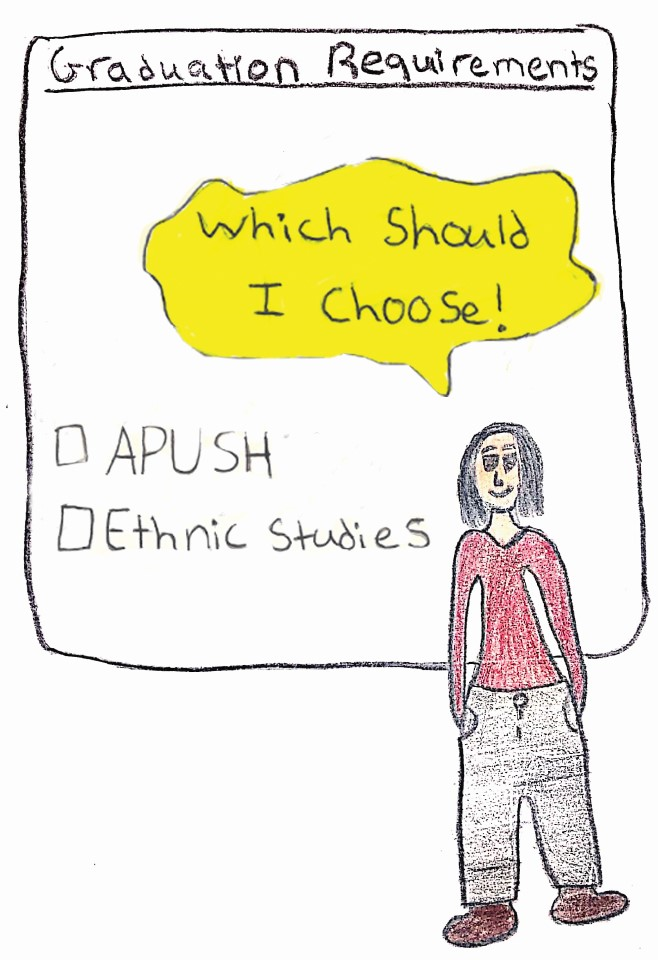
Books, maps, posters, and supplies featured in Jordana Hoyt’s ethnic studies classroom
In the United States, ethnic studies classes began emerging across universities in the 1960s and ‘70s in response to the civil rights movement and the growing demands of Black, Indigenous, and People of Color (BIPOC) for fair and equitable representation in their course curriculums.
Now, there are plans across the country for the class to be taught to kids as young as 5-years-old. Over the past few years, strong coalitions of educators have formed in support of the class being universalized, and steps have been taken by numerous states for mandating the class for high schoolers.
In October, California became the first state requiring students to take a semester of ethnic studies in order to graduate high school. This legislation will first go into effect beginning with the class of 2030.
In response to growing public demands, in 2019, legislation passed by Washington state began requiring lawmakers to make ethnic studies resources available to districts, as well as encouraging districts to incorporate ethnic studies into their curriculums.
Further legislation in 2020 expanded this model, stating, “The office of the superintendent of public instruction shall identify and make available ethnic studies materials and resources for use in grades kindergarten through twelve.”
APUSH vs. Ethnic Studies: What is the difference?
Ethnic Studies U.S. History and its counterpart, AP United States History (APUSH), are the two history classes offered to juniors at Roosevelt High School in order to fulfill American history credit requirements.
According to the College Board, APUSH is an introductory college-level class offered to high schoolers that studies the “cultural, economic, political, and social developments that have shaped the United States from c. 1491 to the present.”
By comparison, the ethnic studies curriculum developed by Seattle Public Schools is the “interdisciplinary study of race and ethnicity, as understood through the perspectives of major underrepresented racial groups in the United States.”
The course also integrates intersectionality — the interconnectedness of various identities and their relationship with systems of power and oppression — through race, gender, sexuality, class, religion, etc. The core themes center around identity, history of resistance and liberation, and reflection and action.
Mia Rush, a senior who previously took the class, says that as a Black student, they were thankful for a space that allowed different identities to be shared from a variety of people, students and teachers alike. Rush added that it felt like the one favorably “off class” where they noticed voices of color and the perspectives of BIPOC being featured.
The ethnic studies course framework used at Roosevelt is a culmination of developments by the district, along with themes influenced by the Washington State Board of Education. At Roosevelt, social studies teachers have adapted the curriculum over the last three years; contributors include Jordana Hoyt, Michael Magidman, Drea Jermann, and Margaret Montgomery.
While the two courses are meant to fulfill the same required American history credit, they teach U.S. history through very different approaches. The most discernible difference is that APUSH tends to cover a broader scope of history while oftentimes failing to analyze nuance, whereas ethnic studies is less comprehensive of overall American history and more thorough in its exploration of specific topics.
“I think that there’s a depth of study that is much more authentic to real learning that AP curriculum doesn’t allow for,” says Hoyt about APUSH. “We have to rush through concepts to touch on all of them, and I think we need more time for more depth.”
Roosevelt APUSH teacher Daniel Gross also reflects on this contrast, saying, “At times there can be parts of U.S. history that are left out [of ethnic studies …] because they decide to go much more in depth into questions of identity and resistance and cultural history.”
This trade-off is further demonstrated by the different course framework for the two curricula. The full course and exam description of APUSH contains 300 pages of detailed instruction. Ethnic studies, on the other hand, consists of 10 pages of guidance.
This imbalance provides context for the difference in freedom that the two classes allow instructors. With more specific instruction to follow, AP teachers have less leeway when it comes to adjusting curriculum because of the sheer amount of content to cover in order to prepare students for the spring AP exam.
“That’s the issue with AP,” explains Hoyt, who previously taught AP Human Geography at Roosevelt. “It’s like someone else is also designing their curriculum and telling you what you can and can’t teach.”
Despite the strict and structured format of the APUSH course, Gross is infusing elements of ethnic studies into his class while still meeting the requirements of the standard APUSH curriculum. “One of the things I am trying to do is, I took the ethnic studies book list that Mr. Magidman and Ms. Hoyt has curated,” he says. “I’m trying to use every single one of the books that they are using in my APUSH class.”
Both Alec Bishop, another ethnic studies teacher at Roosevelt, and Hoyt are very supportive of ethnic studies gaining traction. They expressed how important they consider it to be in high school education.
The gradual addition of ethnic studies into state curriculums country-wide has already enhanced students’ high school performance in the past decade. A 2016 study conducted by Stanford University found that taking an ethnic studies course contributed to higher GPAs and credits earned, as well as increased attendance among students.
Improving Ethnic Studies
The ethnic studies class at Roosevelt places focus on BIPOC history and experiences beyond suffering and trauma. For instance, Black excellence is a topic explored in the class through the Harlem Renaissance of the 1920s and 1930s.
Hoyt mentions, however, that in the ethnic studies class there is still a heavy focus on early history, which is a lot about oppression, and “Not enough about celebration.” Although celebrating BIPOC joy and culture is a step in the right direction, Hoyt says there is still plenty of room for improvement in the ethnic studies class and curriculum.
For example, there needs to be a stronger emphasis on making BIPOC students feel comfortable. Discussion based classes surrounding conversations on race can often create uncomfortable situations for students of color.
According to Rush, ethnic studies may fall guilty to this as well. “I mean, as a Black student, I long for the day where we are granted the ability to leave during conversations about race and just watch,” they say.
However, Rush adds, “I think ethnic studies can be taught so terribly and so wrong, but I think Ms. Hoyt approaches it from a very open-minded perspective.” Here, they reference how ethnic studies’ success as a course heavily relies on an educator’s ability to learn and grow while simultaneously teaching.
Roosevelt is a majority white school with a majority white staff. Rush advises, “When you come into a space as a white teacher, you have to make sure that it is as open and as kind of an environment as you can.” According to them, fostering a safe classroom environment should be of utmost importance to white teachers.
An issue found in many classes at Roosevelt is a lack of diversity. Hoyt comments on this regarding her perspective teaching ethnic studies with three white teachers, saying “I benefit from a lot of privileges. And so as much as I work to reflect, there are a million things I don’t know how to address and I don’t see, and I think this course would be a lot stronger with more perspectives.”
The Trade-Offs with APUSH
APUSH also suffers from this problem where it presents a generally homogenized history of the U.S. that less commonly explores concepts in depth and can often center white male perspectives.
The dominant perspective that social studies classes often tend to is commonly seen in the APUSH curriculum. As most have heard in a social studies class at some point, “History is written by the victors,” and thus, often aligned with their prejudice and bias.
A quote from the current APUSH textbook proves why this saying is still relevant today. It describes an “interaction” between Europeans and Indigenous Americans as: “They [the English] expelled the natives rather than subjugating them.” Gross adds saying, “If you do a deeper dive into that, one could easily conclude that it was a systematic genocide of Indigenous Americans.”
However, students appreciate the course’s tangible benefits: college credit.
Taking AP courses and scoring well on the exams can be direct representations of dedication and hard work that many universities appreciate. In fact, according to the College Board, students who scored a 1 or 2 on their AP exams are 16-19% more likely to enroll in a 4-year university in comparison to similar peers who did not take AP coursework.
Taking the classes traditionally seen as the most “rigorous” while obtaining college credit to save on money and time plays a large factor. For many students choosing to take APUSH over ethnic studies, the perceived benefits of the former outweigh those of the latter.
Bishop adds to this saying, “Some [sophomores when completing their course registration last spring] were very concerned about taking U.S. History ethnic studies and not getting that AP on their transcript.” Bishop reassures students saying, “Colleges aren’t just gonna be looking for the student that takes the most AP classes, they’re gonna be looking for a diverse range of courses too.”

Looking to the Future
In Ethnic Studies U.S. History’s three years at Roosevelt, there has yet to be a single full year of in-person instruction. However, with this, there is much more progress to be made with the course.
The curriculum is still developing and teachers are still looking for ways to create the healthiest and most comforting space for students at Roosevelt, especially the students of color. Hoyt mentions, “It just still feels in its infancy, to be honest. And I want to be clear about that. That it’s still a very new course.”
She adds, “I’m just eager to keep working at it. And that’s why I’m still with it, I want to stick with this course.”



